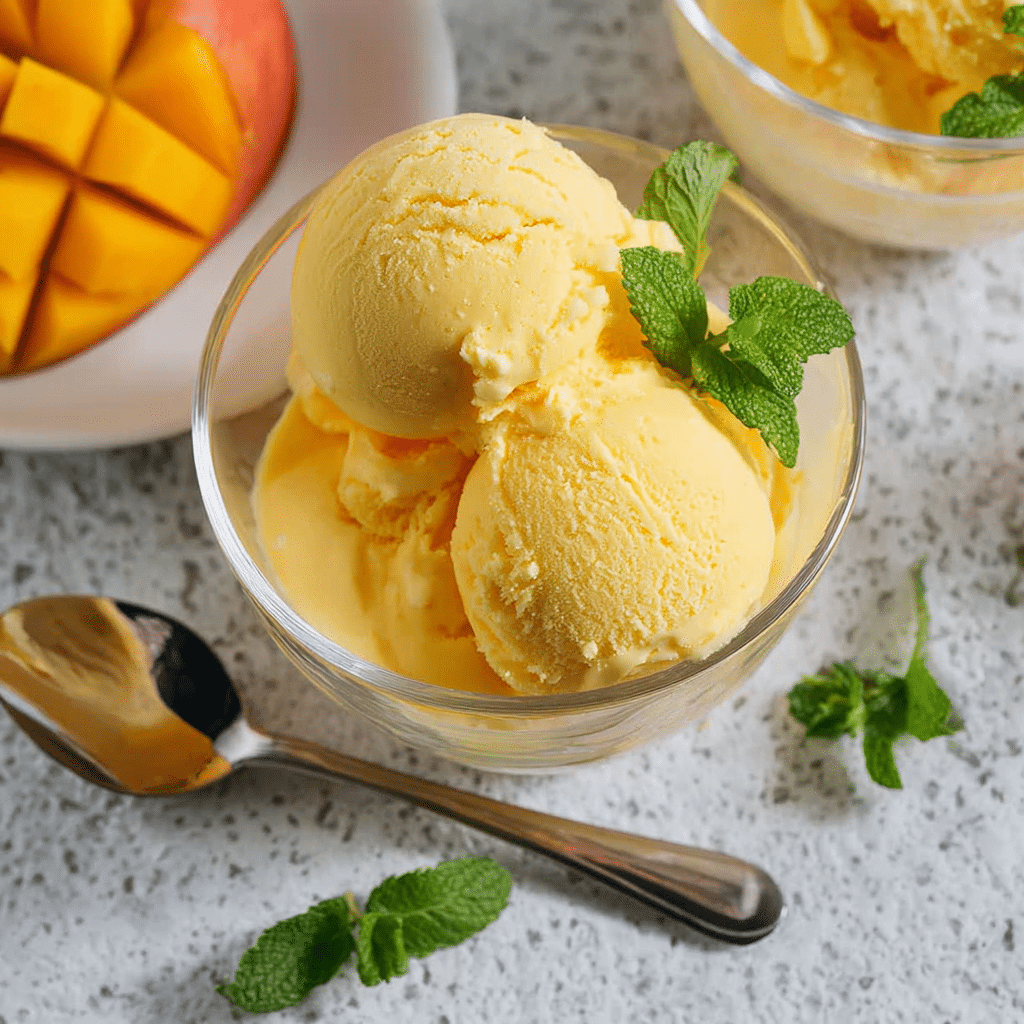The tropical allure of mango is undeniable, and when turned into a silky, homemade gelato, it becomes an unforgettable summer treat. This Mango Gelato recipe captures the essence of ripe mangoes in a smooth, luscious dessert that’s both refreshing and indulgent. Blended with milk, cream, and just a hint of lime, this gelato brings a burst of sunshine in every bite.
Perfect for hot days or special gatherings, this mango gelato stands out not only for its taste but also for its vibrant golden hue. Whether served in a bowl, cone, or as part of a dessert platter, it’s an elegant way to celebrate mango season. Make it once, and it’s sure to become a summer staple in your kitchen!
Full Recipe
Ingredients:
-
3 large ripe mangoes (about 2 ½ cups pulp)
-
1 cup whole milk
-
½ cup heavy cream
-
½ cup sweetened condensed milk
-
¼ cup sugar (adjust based on mango sweetness)
-
1 tablespoon lime juice
-
Pinch of salt
Directions:
-
Peel and chop the mangoes, then blend them until smooth. Strain the puree to remove fibers.
-
In a large bowl, whisk together the mango puree, milk, cream, condensed milk, sugar, lime juice, and a pinch of salt.
-
Chill the mixture in the refrigerator for at least 4 hours or until very cold.
-
Pour the mixture into an ice cream maker and churn according to manufacturer instructions until it reaches a soft-serve consistency.
-
Transfer to an airtight container and freeze for 4–6 hours until firm.
-
Scoop and serve as desired. Garnish with fresh mango cubes or mint leaves for a vibrant touch.
Prep Time: 15 minutes | Chilling/Freezing Time: 6 hours | Total Time: 6 hours 15 minutes
Kcal: 210 kcal | Servings: 6 servings
The Delightful Experience of Mango Gelato
Mango gelato is a celebration of summer, sunshine, and indulgence. This luscious frozen dessert is rooted in Italian culinary tradition and elevated with the exotic sweetness of ripe mangoes. It combines a smooth, creamy texture with the tropical fruit’s naturally vibrant flavor, making it a favorite not only in warm-weather months but year-round for those who crave a refreshing and fruity finish to their meal. Unlike typical ice creams that rely heavily on eggs and a custard base, mango gelato boasts a lighter, silkier consistency that allows the mango to shine as the star ingredient.
What makes mango gelato so special is its simplicity paired with sophistication. It’s not just about freezing fruit; it’s about creating a harmonious blend of fresh mango puree with milk, cream, and just the right touch of sweetness and citrus to balance the richness. This results in a frozen treat that is both decadent and refreshing, making it the perfect dessert for a wide variety of occasions—from backyard barbecues to elegant dinner parties.
The Origins and Essence of Gelato
Gelato, Italy’s answer to ice cream, differs in both preparation and texture. Traditionally churned at a slower speed than ice cream, gelato incorporates less air, leading to a denser and more intensely flavored result. It’s typically served at a slightly warmer temperature, enhancing the richness of taste and mouthfeel. While classic gelato flavors like stracciatella, pistachio, and chocolate dominate Italian gelaterias, fruit-based options such as mango are increasingly popular for their natural sweetness and color.
In mango gelato, the creamy base is combined with ripe mango puree, often from varieties like Alphonso, Ataulfo, or Kesar, known for their intense aroma and smooth texture. The mango is usually blended and strained to remove fibrous bits, ensuring a consistently silky finish. A touch of lime juice is sometimes added to brighten the flavor and deepen the tropical experience.
Healthier Indulgence Without Compromising Flavor
One of the appealing features of mango gelato is that it offers a relatively healthier alternative to traditional ice cream. It typically contains less fat, fewer additives, and no eggs. The fruit content makes it rich in vitamins A and C, and antioxidants, and when made at home, it allows for better control over the sugar and dairy content. Many health-conscious food lovers appreciate mango gelato because it satisfies sweet cravings while remaining lighter on the stomach.
Moreover, mango gelato can be adapted for dietary preferences. By using dairy-free substitutes such as coconut cream or almond milk, it can be made entirely plant-based without sacrificing creaminess. This adaptability is part of what makes it a modern classic—appealing to both traditionalists and contemporary eaters.
Perfect for Entertaining and Everyday Treats
Whether you’re planning a tropical-themed dinner or simply want to cool down on a hot afternoon, mango gelato fits effortlessly into any scenario. It’s elegant enough for serving in individual dessert bowls garnished with mint or fruit slices, yet casual enough to enjoy in a cone at a picnic. Its bright yellow hue makes it visually stunning, often becoming the centerpiece of summer dessert tables.
It also pairs wonderfully with other treats. Serve it alongside coconut macaroons, shortbread cookies, or fruit tarts for a sophisticated dessert platter. For an adult twist, mango gelato can be blended into cocktails or layered in parfaits with fresh fruit and granola for a brunch-worthy presentation.
Cultural Popularity and Versatility
Mango gelato has seen a surge in popularity across the globe, especially in regions where mangoes are a seasonal delight. In Southeast Asia, Latin America, and India, where mango is revered as the “king of fruits,” integrating it into frozen desserts like gelato is a natural evolution. It’s become a cross-cultural dessert that bridges traditional European techniques with tropical ingredients from the Global South.
In cafes and gelaterias around the world, mango gelato is frequently one of the first fruit-based choices to be devoured. It’s also featured in fusion desserts—think mango gelato mochi, mango lassi gelato shakes, or mango gelato-stuffed brioche buns.
Tips for the Best Mango Gelato
When preparing mango gelato at home, ingredient quality makes all the difference. Choose ripe, non-stringy mangoes with a deep orange color and a sweet aroma. Alphonso and Ataulfo are particularly well-suited due to their low fiber and high sweetness. Chill all ingredients before blending, and ensure the mixture is thoroughly cold before churning to achieve the best texture.
If you’re using an ice cream maker, follow the manufacturer’s instructions carefully. For those without one, a no-churn version can still yield excellent results—though the texture may be slightly less smooth. Regular stirring during the freezing process can help reduce ice crystals and preserve creaminess.
Storing mango gelato in an airtight container and letting it sit for a few minutes at room temperature before serving enhances both texture and flavor. Avoid over-freezing, as it can dull the mango’s vibrant taste.
Elevating with Toppings and Add-Ins
Mango gelato is delicious on its own, but creative toppings and mix-ins can elevate it to new levels. Toasted coconut flakes, chopped pistachios, or even swirls of passion fruit puree bring in additional texture and contrast. Drizzles of honey, lime zest, or chili-lime seasoning (for an adventurous twist) give your dessert a gourmet flair.
Another trend involves serving mango gelato in fresh fruit shells—like scooping it into a hollowed-out mango or coconut shell—for a tropical island presentation that impresses both the eyes and the palate.
Why Mango Gelato Belongs in Every Recipe Collection
As a dessert that’s simple to make, easy to adapt, and universally loved, mango gelato checks all the boxes for home cooks and culinary enthusiasts. Its combination of creamy texture and naturally sweet flavor make it stand out from traditional ice creams, while its beautiful golden hue adds elegance to any table. It’s also a great make-ahead option for hosting guests or satisfying weeknight dessert cravings.
Unlike more complicated frozen desserts, mango gelato doesn’t require tempering eggs, boiling custard bases, or long prep times. It’s approachable even for beginners, yet delivers a professional-quality outcome. Whether you’re looking to experiment with homemade gelato for the first time or expand your dessert offerings with a tropical twist, this recipe is sure to be a favorite.
Conclusion
Mango gelato offers more than just a cool treat—it’s a delightful fusion of Italian dessert tradition and tropical fruit bliss. Its creamy, rich texture and naturally sweet mango flavor create a dessert that is as satisfying as it is refreshing. Easy to prepare and endlessly customizable, mango gelato is a modern classic that suits any occasion, from casual family dinners to festive gatherings.
By using quality ingredients and a bit of patience during the chilling and churning process, anyone can recreate this restaurant-worthy dessert at home. Whether enjoyed solo, paired with other desserts, or enhanced with exotic toppings, mango gelato is an irresistible indulgence that brings sunshine to your spoon in every bite.






